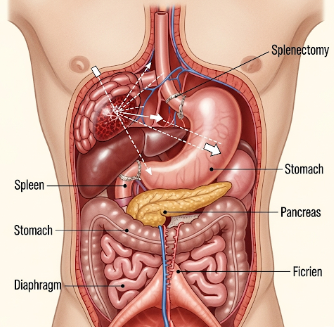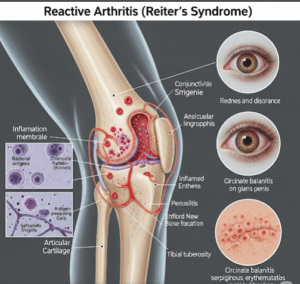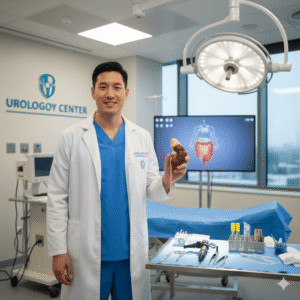Overview
A splenectomy is a surgical procedure to remove the spleen, an organ located in the upper left side of the abdomen, just below the ribcage. The spleen plays an important role in fighting infections and filtering abnormal or damaged blood cells.
Splenectomy is performed when the spleen is damaged, diseased, or causing serious health complications. This can occur due to injuries, cancers, blood disorders, or infections. In Korea, splenectomy is offered in world-class hospitals with advanced surgical technology, laparoscopic techniques, and comprehensive post-surgical care, making it one of the safest destinations for this procedure.
What is a Splenectomy?
A splenectomy is the complete or partial removal of the spleen. There are two main types:
- ✦ Total splenectomy – removal of the entire spleen.
- ➤ Partial splenectomy – removal of part of the spleen, preserving some immune function.
This surgery may be performed using open surgery (traditional incision) or laparoscopic surgery (minimally invasive, using small cuts and cameras).
What are the Benefits?
Splenectomy offers multiple benefits depending on the underlying condition:
✅ Eliminates life-threatening internal bleeding from spleen rupture.
➤ Improves blood cell balance in patients with blood disorders.
✦ Reduces infection risks from damaged or diseased spleens.
➤ Treats cancers and tumors involving the spleen.
✅ Quick recovery with minimally invasive laparoscopic techniques.
✦ Improved quality of life in chronic conditions like immune thrombocytopenia (ITP).
Procedure Details
1) How should I prepare for Splenectomy?
Before surgery, preparation involves:
- ✦ Vaccinations – to protect against infections (pneumococcal, meningococcal, and Haemophilus influenzae).
- ➤ Blood tests and imaging scans (CT, ultrasound) to assess spleen size and condition.
- ✦ Medical history review – checking for bleeding disorders or other health issues.
- ➤ Medication adjustments – stopping blood thinners and certain drugs.
- ✦ Fasting – no food or drink 6–8 hours before surgery.
- ➤ Pre-anesthesia check-up to ensure safety during surgery.
2) What happens during the procedure Splenectomy?
Splenectomy is usually performed under general anesthesia and takes 1–3 hours:
➤ Step 1: The surgeon makes small incisions (laparoscopic) or a larger cut (open) in the abdomen.
✦ Step 2: The spleen is carefully detached from surrounding organs and blood vessels.
➤ Step 3: The blood supply is sealed using sutures, staples, or cauterization.
✦ Step 4: The spleen is removed through the incision.
➤ Step 5: The incision is closed, and a drain may be placed temporarily to prevent fluid build-up.
Laparoscopic splenectomy is preferred whenever possible due to shorter recovery and less pain.
3) What happens after a Splenectomy?
Post-surgery care is crucial for recovery:
- ✦ Patients are monitored in the hospital for 2–5 days.
- ➤ Pain relief and antibiotics are given to prevent infection.
- ✦ Most patients resume light activity in 2 weeks.
- ➤ Full recovery may take 4–6 weeks, depending on the type of surgery.
- ✦ Vaccination updates and possible antibiotic prophylaxis are recommended long-term.
- ➤ Patients are educated about recognizing signs of serious infections, since immunity is lower without a spleen.
Risks / Benefits
Potential Risks:
- ✦ Infection risk (especially serious bacterial infections).
- ➤ Bleeding during or after surgery.
- ✦ Blood clots in veins.
- ➤ Injury to nearby organs (stomach, pancreas, colon).
- ✦ Hernia or wound complications.
Benefits:
- ✅ Life-saving in case of ruptured spleen.
- ✅ Effective treatment for certain cancers and blood disorders.
- ✅ Long-term symptom relief.
- ✅ Improved quality of life with proper follow-up care.
Recovery and Outlook
Recovery is generally smooth, especially with laparoscopic splenectomy:
- ➤ Hospital stay: 2–5 days.
- ✦ Return to daily activities: 2–4 weeks (laparoscopic), 4–6 weeks (open surgery).
- ➤ Lifelong monitoring: for infections, vaccinations, and preventive antibiotics.
- ✦ Prognosis: excellent when combined with good post-surgical care and preventive measures.
Patients without a spleen can live normal, healthy lives but must be more cautious about infections.
When To Call the Doctor
After splenectomy, patients should seek medical help if they experience:
⚠ High fever or chills.
⚠ Severe abdominal pain or swelling.
⚠ Persistent bleeding or pus from the incision site.
⚠ Difficulty breathing or chest pain.
⚠ Signs of serious infection (fatigue, confusion, rapid heartbeat).
Best Korea Option / Process
Korea offers world-class splenectomy care, making it a top destination for this surgery.
- ✦ Highly skilled surgeons experienced in laparoscopic and robotic splenectomy.
- ➤ Internationally accredited hospitals with advanced imaging and operating systems.
- ✦ Comprehensive pre- and post-surgical care, including vaccination programs.
- ➤ Affordable treatment packages compared to the US and Europe.
- ✦ Multidisciplinary care teams (hematology, oncology, gastroenterology).
- ➤ State-of-the-art infection prevention protocols for patients without a spleen.
This makes Korea an excellent choice for patients needing splenectomy with safe recovery and long-term monitoring.
Highlights of Splenectomy in Korea
- ✅ Effective treatment for ruptured, enlarged, or diseased spleens.
- ➤ Advanced laparoscopic and robotic options available.
- ✦ Life-saving procedure for trauma and blood disorders.
- ➤ Excellent recovery rates in Korean hospitals.
- ✅ Affordable, high-quality care with global standards.













